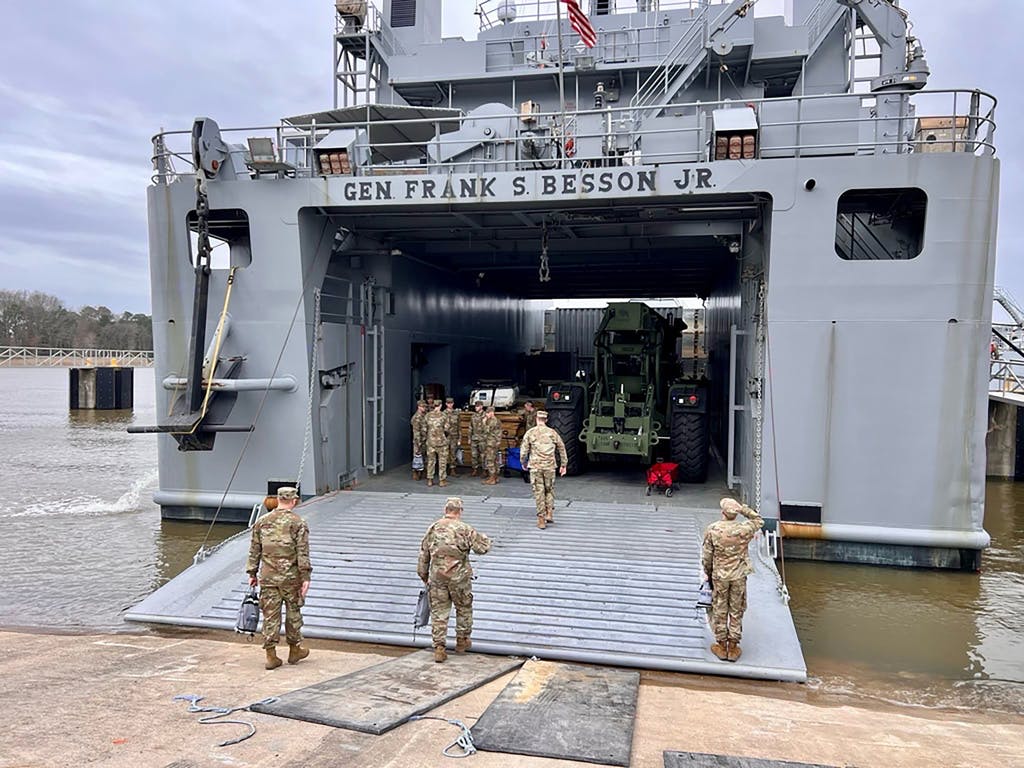Pentagon Acknowledges ‘Risk’ That Hamas Could Fire on Floating Pier Biden Wants for Gaza Aid
Operation to build the platform is already under way as USS Besson sets sail for the Mediterranean with first equipment for the temporary causeway.

If you build it they will come — but they might also try to rain hellfire upon it. That is one of the takeaways from a Pentagon press conference late last week during which the Biden administration’s plan to build a temporary floating pier off the coast of Gaza to facilitate the delivery of food aid to the Strip figured prominently.
The Pentagon press secretary, Major General Pat Ryder, told a group of reporters that Gaza is a “combat zone” and that there is “certainly a risk” that Hamas could try to fire on those involved in building out what he described as a “bridging capability” to enable the delivery of humanitarian assistance.
General Ryder said that “we anticipate that it will take over a thousand American troops to participate in building this capability” and that it will likely take “up to 60 days in order to deploy the forces and construct the causeway and the pier.”
The controversial operation is already under way. On Sunday United States Ship Besson, a logistics support vessel, set sail for the Mediterranean “carrying the first equipment to establish a temporary pier to deliver vital humanitarian supplies,” according to America’s Central Command.
There are currently no plans for American forces to actually touch the ground of Gaza in what will likely be a complicated naval operation fraught with perils both known and unforeseen. On Friday General Ryder said, “I’m not tracking any U.S. military or DoD personnel going on the ground in Gaza,” and emphasized that the Yanks will be “driving the causeway into the beach.”
He said, “There will be others on the receiving end to provide the security, to ensure that aid is distributed. Our forces will stay, you know, either on the causeway or operating those vessels out at sea, to include the floating pier.”
He added that “if Hamas truly does care about the Palestinian people, then again, one would hope that this international mission to deliver aid to people who need it would be able to happen unhindered.”
That statement, however, raises a red flag, because all evidence since October 7 and indeed well before that black day points to Hamas not only not caring about the Palestinian people, and the terrorist group makes no bones about using them as cannon fodder when it suits its goals. Chief among them is staying in power. It is well documented that Hamas has made a practice of hijacking humanitarian aid delivered by land.
What, then, is to stop it from attempting to do the same with aid delivered by sea? General Ryder averred that “we’ve seen reports in the past about Hamas taking aid as well as criminal elements that are attempting to hoard,” but he insisted that “this mission is about getting aid to Gaza, and then working with others for the delivery and distribution.”
The 7th Transportation Brigade Expeditionary, based at Fort Eustis, is the brigade that will build the pier as part of the army’s Joint Logistics Over-the-Shore capability. In 2015 the brigade built such a pier structure in Korea. Yet with the world’s attention now fixated on Gaza, the visibility of a similar undertaking there will be much higher.
General Ryder explained how it will work: “In essence, what you’ll have is a floating pier that is off shore, that will be able to receive commercial vessels that have aid. That aid will be offloaded onto the floating pier and then transloaded onto Navy support vessels, what we call logistics support vessels, LSVs. Those vessels will then take it to the floating causeway.” He specified that the two-lane causeway will be about 1,800 feet long and from it the aid will then be “transported onto land and then distributed into Gaza.”
He hinted that if the operation were to come under attack it could be defended. “The Department of Defense maintains the ability to provide unique capabilities from offshore without a U.S. military presence within Gaza,” he said, adding that the “concept that is being planned for temporary offshore maritime pier … does not require U.S. military personnel to go ashore.”
The burden of securing the corridor from the pier to the receiving area on land will likely fall to the IDF — which already has quite a full plate in the region. Delivery of humanitarian aid by sea could in a roundabout way ease pressure on Israel by bypassing Hamas control over aid meant to come via land crossings with Israel and Egypt.
Yet, can enough food aid be offloaded to make a tangible difference? Would it make it any easier for the IDF to conduct an operation to rout Hamas holdouts at Rafah? Or will President Biden’s latest gambit in the already tense region actually keep Hamas thugs pottering about Gaza for longer than is necessary?
All of that is unknown — as is to what extent several hundred Americans could come into harm’s way. Sixty days is a long time in any war, particularly in the Middle East. In that span of time much could happen to change facts on the ground — or at sea.

